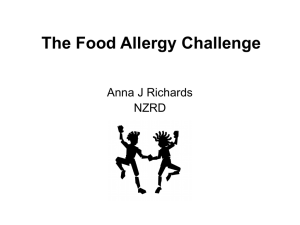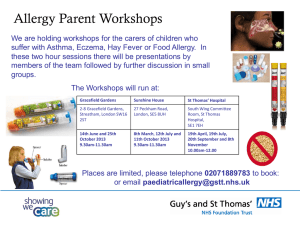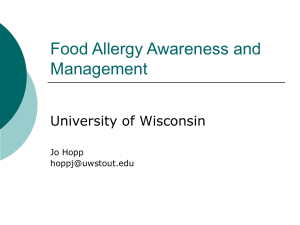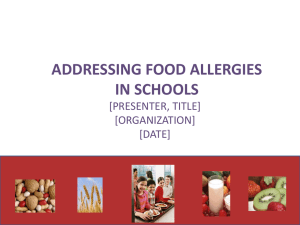Food Allergies and Food Intolerances PowerPoint
advertisement
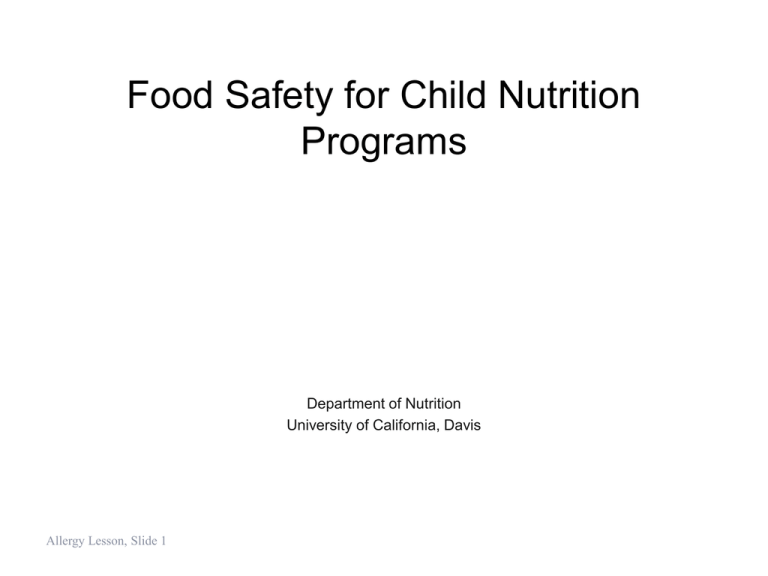
Food Safety for Child Nutrition Programs Department of Nutrition University of California, Davis Allergy Lesson, Slide 1 Food Safety for Child Nutrition Programs Supplemental Lesson: Food Allergies and Food Intolerances Allergy Lesson, Slide 2 Lesson Competency • Develop an understanding of the causes and symptoms of food allergies and intolerances, and the responsibilities of food service establishments in preventing life-threatening reactions. Allergy Lesson, Slide 3 Performance Standards • Describe the differences between food allergies and intolerances. • Identify the eight most common food allergens. Allergy Lesson, Slide 4 Performance Standards • Identify school nutrition program responsibilities and requirements for accommodating children with food allergies or intolerances. • Demonstrate methods for managing food allergies. Allergy Lesson, Slide 5 Vocabulary • Food allergy: A specific type of immune system response to a food. • Allergen: A substance that causes an allergic reaction. • Antibodies: A protein in the body that reacts and attaches to specific substances. • Antigen: A protein or other substance that antibodies attach to. Allergy Lesson, Slide 6 Vocabulary • Mast cells: A type of immune system cell found in body tissues. • Basophils: A type of immune system cell found in blood. • Immunoglobin E (IgE): A type of antibody found on basophils and mast cells. • Anaphylaxis: A severe allergic reaction that results in a drop in blood pressure and difficulty breathing. Allergy Lesson, Slide 7 Vocabulary • Food intolerance: A sensitivity to a food that does not involve IgE. • Celiac disease: A immune system reaction to gluten that causes damage to the lining of the intestine. • Lactose intolerance: Inability to digest lactose. Allergy Lesson, Slide 8 Vocabulary • Medical Statement to Request Special Meals and/or Accommodations: Required form when meal accommodations are made to insure they are reimbursable. • Cross-contact: When allergens from a food are transferred to another food. Allergy Lesson, Slide 9 Immune System • The immune system is the part of the body that fights infection. • One way the immune system fights infection is through antibodies. Antibodies attach to antigens to make them unable to work and to signal to the immune system that an invasion is taking place. Allergy Lesson, Slide 10 Immune System • The antibodies on basophils (immune system cells in the blood) and mast cells (immune system cells found in other types of body tissues) are called Immunoglobin E, or IgE. • IgE bind to antigens, which signals the mast cell or basophil to release immune system chemicals to fight the infection. Allergy Lesson, Slide 11 Food Allergies • Food allergies occur when the body responds to an antigen in food by creating antibodies that attach themselves to this molecule. The binding of antibodies to the antigen causes the immune system to react, which causes the symptoms of a food allergy. • When someone has a food allergy, it is sometimes called an IgE-mediated food allergy, because that is the type of antibody involved. Allergy Lesson, Slide 12 Symptoms of a Food Allergy • An allergic reaction to a food can take from a few minutes to a few hours to show symptoms. Allergy Lesson, Slide 13 Symptoms of a Food Allergy • Symptoms may include: – – – – – – – – Swelling of the mouth, lips, and/or tongue Itchiness in the mouth Rash and/or hives Runny nose Throat tightness Trouble breathing Vomiting, diarrhea, GI pain Anaphylaxis Allergy Lesson, Slide 14 Anaphylaxis Anaphylaxis is the most dangerous food allergy reaction, because it can result in death if not treated quickly. Allergy Lesson, Slide 15 Symptoms of Anaphylaxis • Symptoms include: – – – – Drop in blood pressure Hives, itching, swelling of the mouth, lips, tongue Difficulty swallowing Constriction of the airway, which can cause wheezing, difficulty breathing – Weak or rapid pulse – Nausea, vomiting, diarrhea – Dizziness or fainting Allergy Lesson, Slide 16 Anaphylaxis • When someone has an anaphylactic reaction, injection with an epinephrine autoinjector (e.g. EpiPen) is necessary, followed by a visit to the emergency department to make sure symptoms don’t return. Allergy Lesson, Slide 17 Most Common Food Allergens • While an allergy can develop to almost any food or ingredient, these are the most common food allergies: 1. 2. 3. 4. 5. 6. 7. 8. Allergy Lesson, Slide 18 Milk Eggs Peanuts Tree nuts Fish Shellfish Soy Wheat Food Intolerance • A food intolerance is a reaction to a food that is not IgE-mediated. • Some food intolerances that you may encounter in your program are: – Celiac disease – Lactose intolerance Allergy Lesson, Slide 19 Celiac Disease • Celiac disease is a reaction to gluten that results in the immune system attacking the lining of the gut. • This leads to damage to the lining of the intestine that causes pain, diarrhea, gas, bloating. If the damage becomes bad enough, it can lead to malnutrition. • Celiac disease is treated by removing gluten from the diet. Allergy Lesson, Slide 20 Celiac Disease: What to Avoid • Those will celiac disease need to avoid WROB: – – – – Wheat Rye Oats Barley Allergy Lesson, Slide 21 Lactose Intolerance • Lactose intolerance happens when a person makes little or no lactase, the enzyme that digests lactose. • Symptoms of lactose intolerance are bloating, gas, and/or diarrhea after eating foods containing lactose. • Those with lactose intolerance need to avoid foods with lactose in order to avoid symptoms. Allergy Lesson, Slide 22 Federal Requirements • The US Department of Agriculture requires substitutions or modifications in the National School Lunch Program and School Breakfast program for children whose disabilities restrict their diet. • Title 7, Code of Federal Regulations, sections 15.3(b) and 210.10(g) Allergy Lesson, Slide 23 Medical Statement to Request Special Meals and/or Accommodations • The USDA requires a written medical statement to request special meals and/or accommodations to ensure that the child’s meal is reimbursable. • This form is available at: http://www.cde.ca.gov/ls/nu/sn/fm.asp • This form must be signed by a recognized medical authority. Allergy Lesson, Slide 24 Recognized Medical Authority • For a child with a disability, the recognized medical authority can be a: – Licensed physician • For a child without a disability, but with a special dietary need, the recognized medical authority can be a: – Licensed physician – Physician assistant – Nurse practitioner Allergy Lesson, Slide 25 The American with Disabilities Act Amendments Act of 2008 (ADAAA) • The ADAAA expanded the definition of disability to include “Major Bodily Functions”, which includes digestive and bowel functions, among others. • This may mean that more children in your program could be identified as having a foodrelated disability. Allergy Lesson, Slide 26 Guidance for Accommodations • The USDA Food and Nutrition Service is updating the guidance Accommodating Children with Special Dietary Needs in the School Nutrition Programs, Guidance for School Food Service Staff. • For more information, see USDA FNS Memo SP 36-2013, CACFP 10-2013, SFSP 12-2013. Allergy Lesson, Slide 27 Accommodating Children with Food Allergies or Intolerances • Generally those with a food allergy or intolerance do not have a disability as defined by the legislation. • If a food allergy results in a severe, lifethreatening reaction, it is considered a disability, and must be accommodated. • The expanded definition of a disability may now also include celiac disease. Allergy Lesson, Slide 28 Accommodating Children with Food Allergies or Intolerances • For other food allergies and intolerances, agencies may, but are not required to make accommodations. • These accommodations still require a written medical statement, signed by a recognized medical authority. Allergy Lesson, Slide 29 Does this meet the requirements? • A child’s parent brings a note signed by a licensed vocational nurse that states the child has an intolerance to beans. Is this enough to make an accommodation? Allergy Lesson, Slide 30 Does this meet the requirements? • A child’s parent brings a note signed by a licensed vocational nurse that states the child has an intolerance to beans. Is this enough to make an accommodation? • No. A licensed vocational nurse is not a licensed medical authority, and a signed note is not a Medical Statement to Request Special Meals and/or Accommodations. Allergy Lesson, Slide 31 Developing a Food Allergy Management Plan • Have a written plan for how you will handle food allergies. • Some questions to consider when developing a food allergy management plan: – Who will answer questions regarding menu items? – Who will be responsible for checking the ingredients used in menu items? – What steps should the kitchen staff follow to avoid cross-contact? – How should staff members handle an allergic reaction? Allergy Lesson, Slide 32 Managing Food Allergies in the Kitchen and Cafeteria • • • • • Know what to avoid and substitute Read labels Prepare the kitchen and cafeteria Identify the students Develop cleaning procedures Allergy Lesson, Slide 33 Know What to Avoid and Substitute • Ask parents of a child with a food allergy to provide a list of food ingredients to be avoided. • Don’t rely on lists of “safe” prepackaged food, as ingredients can change without warning. • Include allergen information on your recipes to help identify which menu items may cause a reaction. Allergy Lesson, Slide 34 Read Labels • Develop a system for checking ingredient labels on all foods that will be served to a child with a food allergy. • Be aware that some foods can have hidden allergens. Allergy Lesson, Slide 35 Hidden Allergens • Examples: – Hot dogs and luncheon meat may have ingredients derived from milk. – Enchilada sauce or hot sauce may contain peanuts. – Imitation crab meat contains egg. • For more information on hidden allergens: – NSFMI Reading Labels for Food Allergens Fact Sheet: http://www.nfsmi.org/documentlibraryfiles/PDF/200902100 32840.pdf – Food Allergy Research and Education website: http://www.foodallergy.org/allergens Allergy Lesson, Slide 36 Prepare the Kitchen and Cafeteria • Designate an area in the kitchen where allergyfree meals can be prepared. • This area should be kept free of ingredients allergic students should avoid. • Have allergy-free tables in the cafeteria for students who need them. Allergy Lesson, Slide 37 Identify the Students • Have a policy in place to identify the students moving through the cafeteria line that need allergen-free meals. Allergy Lesson, Slide 38 Develop Cleaning Procedures • Designate a person responsible for ensuring that lunch tables and surrounding areas are thoroughly cleaned before and after lunch. • Use a designated sponge or cleaning cloth for allergy-free tables. Allergy Lesson, Slide 39 Case Study • Geneva is a child in third grade who has a milk allergy. Her parents don’t keep milk in the house, and send her to school every day with a sack lunch. Her school has two lunch periods, and Geneva eats during the second one. • One day, Geneva sits down at her usual table to eat her lunch, and then develops a rash on her hands and wrists. Allergy Lesson, Slide 40 Case Study • What do you think is the cause of Geneva’s rash? • How could this be prevented? Allergy Lesson, Slide 41 Case Study • What do you think is the cause of Geneva’s rash? – Her rash was caused by milk residue left on the table, because it wasn’t cleaned properly between lunch periods. • How could this be prevented? – Wash the lunch tables between lunch periods with hot soapy water to remove the allergens. – Have a designated table for children with allergies, and make sure that it is thoroughly cleaned before they use it. Allergy Lesson, Slide 42 Cross Contact • Cross contact is when a food that does not contain an allergen comes into contact with a food that does. • It does not have to be direct contact. For example, a knife used to spread peanut butter, if it is not cleaned thoroughly after use, could spread peanut protein to a jar of jam. Allergy Lesson, Slide 43 Preventing Cross Contact • Clean surfaces, equipment, pans, and utensils with hot, soapy water before preparing allergenfree foods. • Use a separate cutting board for allergen-free foods. • Wash hands with soap and water to remove allergens. Alcohol-based sanitizers are not effective. Allergy Lesson, Slide 44 Preventing Cross Contact • Use soap or commercial cleaning agents to remove allergens from table tops. • If you are cooking several foods at the same time, cook allergen-free foods first, then keep them covered and away from other foods that are cooking. • If you have handled any foods with allergens, wash hands thoroughly before serving allergenfree meals. Allergy Lesson, Slide 45 HACCP for Food Allergies • HACCP can be adapted to identify and control protential food allergy problems before they happen. Allergy Lesson, Slide 46 HACCP Steps 1. 2. 3. 4. 5. 6. 7. Identify hazards Identify control points Establish critical limits Establish monitoring procedures Establish corrective actions Establish verification procedures Establish record-keeping procedures Allergy Lesson, Slide 47 Identify Hazards • Identify allergens in the foods in your kitchen and the menu items you prepare and serve. Allergy Lesson, Slide 48 Identify Control Points • Receiving and Storage – Store allergen-free foods away from foods that contain allergens. • Food Preparation – Designate a special prep area, cutting boards, knives, etc. to prevent cross contact. • Cooking – Use clean equipment that has not been used to cook other foods, and cook allergen-free foods first. Allergy Lesson, Slide 49 Identify Control Points • Holding food – Hold allergen-free foods covered and away from other foods. • Serving food – Wash hands thoroughly before serving allergen-free meals. Allergy Lesson, Slide 50 Establish Critical Limits There are no safe limits of allergens. Even microscopic food particles are enough to cause a reaction! Allergy Lesson, Slide 51 Establish Monitoring Procedures • Establish who will monitor each critical control point to make sure that safe foods are used, and no cross contact occurs. • Establish when and how this person will monitor the critical control point. Allergy Lesson, Slide 52 Establish Corrective Actions • Establish what actions a monitor should take if a critical control point is not met. • If an ingredient changes and now contains an allergen it did not have before, communicate this to all team members. • If cross contact occurs, the items should be discarded and prepared fresh, taking care to prevent cross contact from occurring again. Allergy Lesson, Slide 53 Establish Verification Procedures • Make sure the HACCP plan is eliminating food allergy hazards Allergy Lesson, Slide 54 Establish Record-Keeping Procedures • Decide what records need to be kept to: – Prevent ingredients or foods that contain allergens from being served to those with allergies – Determine if the HACCP plan is working Allergy Lesson, Slide 55 Activity – Identify the Common Allergens Breakfast Burrito • Fresh large eggs • Frozen whole-kernel corn • Low fat 1% milk • Fresh green peppers, diced • Fresh onions, diced Allergy Lesson, Slide 56 • • • • • Fresh tomatoes, diced Yellow mustard Hot pepper sauce Salt Reduced fat cheddar cheese • Flour tortillas Activity – Identify the Common Allergens Breakfast Burrito • Fresh large eggs • Frozen whole-kernel corn • Low fat 1% milk • Fresh green peppers, diced • Fresh onions, diced Allergy Lesson, Slide 57 • • • • • Fresh tomatoes, diced Yellow mustard Hot pepper sauce Salt Reduced fat cheddar cheese • Flour tortillas Activity – Identify Possible Hidden Allergens Breakfast Burrito • Fresh large eggs • Frozen whole-kernel corn • Low fat 1% milk • Fresh green peppers, diced • Fresh onions, diced Allergy Lesson, Slide 58 • • • • • Fresh tomatoes, diced Yellow mustard Hot pepper sauce Salt Reduced fat cheddar cheese • Flour tortillas Activity – Identify Possible Hidden Allergens Breakfast Burrito • Fresh large eggs • Frozen whole-kernel corn • Low fat 1% milk • Fresh green peppers, diced • Fresh onions, diced Allergy Lesson, Slide 59 • • • • • Fresh tomatoes, diced Yellow mustard Hot pepper sauce Salt Reduced fat cheddar cheese • Flour tortillas Activity – Identify Cross-Contact Concerns Breakfast Burrito • Fresh large eggs • Frozen whole-kernel corn • Low fat 1% milk • Fresh green peppers, diced • Fresh onions, diced Allergy Lesson, Slide 60 • • • • • Fresh tomatoes, diced Yellow mustard Hot pepper sauce Salt Reduced fat cheddar cheese • Flour tortillas Activity – Identify Cross-Contact Concerns Breakfast Burrito • Fresh large eggs • Frozen whole-kernel corn • Low fat 1% milk • Fresh green peppers, diced • Fresh onions, diced Allergy Lesson, Slide 61 • • • • • Fresh tomatoes, diced Yellow mustard Hot pepper sauce Salt Reduced fat cheddar cheese • Flour tortillas Review Questions 1. Which of the following is one of the most common food allergies? a. b. c. d. Gluten Strawberries Wheat MSG Allergy Lesson, Slide 62 Review Questions 1. Which of the following is one of the most common food allergies? a. b. c. d. Gluten Strawberries Wheat MSG Allergy Lesson, Slide 63 Review Questions 2. Food allergies are mediated by which of the following? a. b. c. d. Immunoglobin E (IgE) Immunoglobin G (IgG) Histamine Epinephrine Allergy Lesson, Slide 64 Review Questions 2. Food allergies are mediated by which of the following? a. b. c. d. Immunoglobin E (IgE) Immunoglobin G (IgG) Histamine Epinephrine Allergy Lesson, Slide 65 Review Questions 3. Which of the following is NOT a symptom of a food allergy? a. b. c. d. Itchiness in the mouth Rash or hives Runny nose Fever Allergy Lesson, Slide 66 Review Questions 3. Which of the following is NOT a symptom of a food allergy? a. b. c. d. Itchiness in the mouth Rash or hives Runny nose Fever Allergy Lesson, Slide 67 Review Questions 4. Which of the following statements about anaphylaxis is true? a. b. c. d. It is a symptom of celiac disease. It is only caused by peanut allergies. It can result in death if not treated. It is treated with antihistamines. Allergy Lesson, Slide 68 Review Questions 4. Which of the following statements about anaphylaxis is true? a. b. c. d. It is a symptom of celiac disease. It is only caused by peanut allergies. It can result in death if not treated. It is treated with antihistamines. Allergy Lesson, Slide 69 Review Questions 5. People with celiac disease need to avoid which of the following? a. b. c. d. Wheat, Rice, Oats, and Barley Wheat, Rye, Oats, and Barley Rye, Rice, Oats, and Lactose Wheat, Lactose, Casein, and Whey Allergy Lesson, Slide 70 Review Questions 5. People with celiac disease need to avoid which of the following? a. b. c. d. Wheat, Rice, Oats, and Barley Wheat, Rye, Oats, and Barley Rye, Rice, Oats, and Lactose Whey, Lactose, Rye, and Oats Allergy Lesson, Slide 71 Review Questions 6. Which of the following can sign a Medical Statement to Request Special Meals and/or Accommodations? a. b. c. d. Registered nurse Registered dietitian Licensed pharmacist Licensed physician Allergy Lesson, Slide 72 Review Questions 6. Which of the following can sign a Medical Statement to Request Special Meals and/or Accommodations? a. b. c. d. Registered nurse Registered dietitian Licensed pharmacist Licensed physician Allergy Lesson, Slide 73 Review Questions 7. Which of the following is TRUE about accommodating food allergies and intolerances? a. Agencies are required to make accommodations for all allergies and intolerances. b. Accommodations for food intolerances do not require a signed medical statement. c. A food allergy that results in a severe, lifethreatening reaction is considered a disability. d. A note on a physician’s letterhead can substitute for a signed medical statement. Allergy Lesson, Slide 74 Review Questions 7. Which of the following is TRUE about accommodating food allergies and intolerances? a. Agencies are required to make accommodations for all allergies and intolerances. b. Accommodations for food intolerances do not require a signed medical statement. c. A food allergy that results in a severe, lifethreatening reaction is considered a disability. d. A note on a physician’s letterhead can substitute for a signed medical statement. Allergy Lesson, Slide 75 Review Questions 8. What is it called when a food that does not contain an allergen comes into contact with a food that does? a. b. c. d. Cross contact Cross contamination Hidden allergen Control point Allergy Lesson, Slide 76 Review Questions 8. What is it called when a food that does not contain an allergen comes into contact with a food that does? a. b. c. d. Cross contact Cross contamination Hidden allergen Control point Allergy Lesson, Slide 77 Review of Lesson Performance Standards Allergy Lesson, Slide 78 Describe the differences between food allergies and intolerances. Allergy Lesson, Slide 79 Describe the differences between food allergies and intolerances. • A food allergy is an immune system reaction to a food that is mediated by Immunoglobin E (IgE) • A food intolerance is a reaction to a food that is not IgE mediated. • A food allergy can cause life-threatening anaphylaxis, while a food intolerance can not. Allergy Lesson, Slide 80 Identify the Eight Common Food Allergens Allergy Lesson, Slide 81 Identify the Eight Most Common Food Allergens 1. 2. 3. 4. 5. 6. 7. 8. Milk Eggs Peanuts Tree nuts Fish Shellfish Soy Wheat Allergy Lesson, Slide 82 Identify School Nutrition Responsibilities and Requirements for Accommodating Children with Food Allergies or Intolerances Allergy Lesson, Slide 83 Identify School Food Service Responsibilities and Requirements for Accommodating Children with Food Allergies or Intolerances • Schools must accommodate children with disabilities, and a life-threatening reaction to a food is considered a disability. • For all other allergies and intolerances, schools may choose to make accommodations. • Accommodations require a written medical statement signed by a medical authority. Allergy Lesson, Slide 84 Demonstrate Methods for Managing Food Allergies in the Kitchen and Cafeteria Allergy Lesson, Slide 85 Demonstrate Methods for Managing Food Allergies in the Kitchen and Cafeteria • • • • • Know what to avoid and substitute Read labels Prepare the kitchen and the cafeteria Identify the students Develop cleaning procedures Allergy Lesson, Slide 86 Food Safety for Child Nutrition Programs Thank You Department of Nutrition University of California, Davis Allergy Lesson, Slide 87

